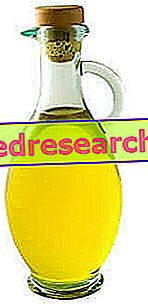Generality
What are Omega 6s?
The omega 6 are a family of lipids, to which belong the essential fatty acid linoleic acid (LA) and the semi-essential gamma linolenic acid (GLA), diomo-gamma-linolenic acid (DGLA) and arachidonic acid (AA)
Do omega-6s increase or decrease cardiovascular risk?
Omega 6 are essential and semi essential fatty acids that play a promiscuous role in cardiovascular risk:
- Positive role: some metabolic parameters improve, above all lipemia and in particular cholesterolemia, reducing the cardiovascular risk.
- Negative role: it is possible that some of them, if present in excess and for the reasons that we will explain below, increase the cardiovascular risk.
Omega 6 and Cholesterol
The right dose of omega 6 decreases cardiovascular risk

The reduction of total cholesterol is mainly observed, due to the reduction of the bad cholesterol or LDL (Low Density Lipoprotein).
In reality, there is no real evil cholesterol; cholesterol is "more or less" all the same (we omit the details of a purely chemical nature).
The intake of omega 6 does not reduce the production of cholesterol by the liver, but the synthesis of LDL.
LDLs are special transporters of blood fats, which carry lipids from the liver to the peripheries.
If in excess, peripheral cholesterol tends to deposit in the arteries participating in atherosclerosis. That is why, by reducing LDL, omega 6 can help reduce cardiovascular risk.
The scientific evidence supporting a possible improvement effect of the omega 6 on the synthesis of good cholesterol or HDL (High Density Lipoprotein) is less evident, which sometimes even seem to decrease.
In contrast, HDLs increase significantly due to physical motor activity.
- To obtain the maximum metabolic result from the consumption of omega 6 it is necessary that, together with omega 3, they replace the so-called "bad fats" (saturated, hydrogenated and above all in trans conformation).
- Furthermore, as we will see later, it is essential to respect the "overall caloric constraint". A diet too rich in fats predisposes to overweight and, even if composed of lipids of excellent quality, risks nullifying the protective effect of the latter on cardiovascular risk.
Linoleic acid, as well as omega 3:
- Decreases blood pressure
- The production of PAI (antifibrinolytic molecule) decreases
- Increases insulin sensitivity
These are all aspects that reduce cardiovascular risk.
Omega 6 and Inflammation
Excess omega 6 is considered to be potentially harmful to the body; let's see why.
Excess arachidonic acid increases inflammation and cardiovascular risk
The excess of AA appears to alter the body's inflammatory balance.
AGEs are responsible for the production of eicosanoids, some of which are anti-inflammatory (commonly called good) and other proinflammatory (called bad).
While omega 3 and some omega 6 (GLA) produce good anti-inflammatory eicosanoids, some omega 6 and in particular arachidonic acid are precursors of the bad proinflammatory ones (inflammatory cascade).
Increased inflammation is a factor that greatly increases cardiovascular risk.
The Omega 6s damage the Omega 3s
Excess omega 6 decreases the effect of omega 3 and increases cardiovascular risk
An excess of omega 6, especially linoleic acid, is harmful to the metabolism of omega 3.
The essential fatty acids (AGE omega 6 and omega 3) are processed in the cells thanks to the effect of the same enzymes. Therefore, the excess of omega 6 tends to "occupy" all these biological catalysts, affecting the metabolism of omega 3 (for example, it reduces the production of eicosapentaenoic acid EPA and docosahexaenoic DHA). Furthermore, omega 3 is less present in the diet.

It is good to remember that, even if the omega 3 have a better effect from the inflammatory point of view, they have no significant impact on cholesterolemia; however, they seem to effectively reduce blood triglycerides.
This suggests that both omega 3 and omega 6 play an important but not interchangeable role in reducing cardiovascular risk.
Types of eicosanoids
In the tables below are summarized:
- The types of eicosanoids that can be obtained from essential fatty acids
- The formation of eicosanoids starting from AGE.
| eicosanoids | Abbreviation |
| Prostaglandins | PG |
| thromboxanes | TX |
| prostacyclin | PGI |
| Leukotrienes | LK |
| Essential Fatty Acid | Abbreviation | Formula | Series of eicosanoids produced | ||
| TX PG PGI | LK | Effects | |||
| Gamma linolenic acid | GLA | 18: 3ω6 | Series-1 | 3-Series | Less inflammatory |
| Diologamma linolenic acid | DGLA | 20: 3ω6 | Series-1 | 3-Series | Less inflammatory |
| Arachidonic acid | AA | 20: 4ω6 | Series-2 | Series-4 | More inflammatory |
| Eicosapentaenoic acid | EPA | 20: 5ω3 | 3-Series | Series-5 | Less inflammatory |
Synthesis
Fundamental concepts concerning the correlation between omega 6 and cardiovascular risk
Below we will summarize the most important concepts regarding the effects of omega 6 on the human body:
- Omega 6s have a markedly positive effect on cholesterolemia.
- To maximize the benefits from the diet, it is necessary that omega 6 and omega 3 replace saturated and hydrogenated fats (especially trans).
- Linoleic acid does not appear to affect triglyceride levels.
- Some studies have shown a potential for reducing blood pressure and PAI, two aspects that would make LA increasingly similar to omega-3.
- Higher intake of linoleic acid is associated with better insulin sensitivity.
- In almost all of the studies, the intake of omega 6 is associated with a significant reduction in the risk of heart attack; in a famous study of US nurses (Nurses' Health Study), women with a higher intake of linoleic acid had a 30% lower risk of heart attack than others.
- In vivo, omega 6 (all) are showing a near-zero pro-inflammatory potential, denying the results previously obtained in vitro.
- By carefully analyzing certain markers (cytokines), the intake of certain omega 6 seems to correlate with good improvements in the parameters of systemic inflammation.
- Nutrition should favor the intake of foods rich in omega 3, as they are less frequent and in lower concentrations in food.
- Although the existence of a clear and linear correlation between the content of linoleic acid in the diet and the reduction of cardiovascular risk is now proven, exaggerate with the intake of certain omega 6 (especially arachidonic acid), compared to a low intake of omega 3, could increase the risk of developing pathologies with inflammatory / autoimmune etiology.
- However, if the diet is characterized by an omega 6 / omega 3 ratio of just over the norm, it would not seem the case to be too alarmed.
Conclusions
- On balance, it seems that the alteration of the relationship between omega 3 and omega 6 in favor of the latter is far less important than expected.
- We also remember that the Italian population is still lacking in essential fatty acids in the diet; therefore, it is advisable to try to increase their consumption by replacing SATURI fats of animal origin (and hydrogenated fats containing trans acids), with polyunsaturated fats contained in seasoning oils (cold extracted) and blue fish, salmon, cod etc (if possible caught and not bred).
- Ultimately, by varying the type of seasoning oils (in addition to extra virgin olive oil including soy, corn, grape seeds, walnut etc.), increasing the consumption of fish, reducing that of egg yolk and derivatives of milk ... it is possible to increase the intake of essential polyunsaturated fatty acids, including omega 6.
Recommended dietary intake of omega 6 : the dietary intake of omega 6 for the prevention of cardiovascular risk should be in the order of 5-10% of total daily calories. These are therefore more generous percentages than those recommended by the LARN (2%).
Decrease Cardiovascular Risk
How can cardiovascular risk be reduced?
To decrease the cardiovascular risk it is necessary to intervene on all the predisposing factors (except obviously for the genetic ones):
- Being in normal weight
- Maintain metabolic homeostasis
- Eat in a balanced way, focusing on the contribution of beneficial nutrients
- Practice physical activity
- Avoid negative agents such as smoking, alcoholism etc.
What does normal weight mean?
It means normal weight.
Maintaining a normal weight while maintaining the right balance between fat mass and fat-free mass avoids overweight.
Obesity, a severe form of overweight, is the result of an incorrect diet and a sedentary lifestyle.
Obesity worsens the metabolism and increases cardiovascular risk.
What does metabolic homeostasis mean?
In medical terms, metabolic homeostasis means the balance of all vital parameters and indicators of health status.
The body is not in metabolic homeostasis when it suffers from significant changes in parameters such as: cholesterolemia, triglyceridemia, blood glucose, homocysteinemia, uricemia and blood pressure.
If these variations become serious and permanent, we speak of metabolic pathologies or of replacement or well-being.
One or more of the following factors can be responsible: incorrect diet, obesity, sedentary lifestyle, negative agents and genetic predispositions.
What does it mean to eat in a balanced way?
The diet is defined as balanced when it is sufficient to support the body functions and guarantees the maintenance of the state of health.
It is highly specific and changes according to the subject.
In order for it to be balanced, nutrition must provide all the essential nutrients, those needed and the nutritional factors the body needs.
What are the beneficial nutrients and nutritional factors?
They are obviously the ones that are good for health.
Some of these are essential, that is that the body must necessarily introduce with the diet (for example the omega 6 of which we spoke) or simply necessary to maintain a good overall physical function.
A third category is that of useful nutritional factors, which however cannot be defined as "vital in the short term". This is the case of fibers, phenolic antioxidants, lecithins, phytosterols, etc. (which seem to have a positive effect on cardiovascular risk).
Practice physical activity and abolish harmful behaviors
Physical motor activity increases caloric expenditure, improves metabolic efficiency, prevents obesity, optimizes metabolic homeostasis, induces a healthy lifestyle free from harmful behaviors (smoking, alcoholism, drug use, disorderly eating etc).
Fat and Cardiovascular Risk
It is right to reiterate once again that the type of fat present in the diet is among the most influential elements on cardiovascular risk.
We must also avoid obesity, treat nutritional balance and take the right amount of useful molecules, limiting the harmful ones.
In order to reduce the cardiovascular risk it is advisable to prevent hypercholesterolemia, type 2 diabetes mellitus, hypertriglyceridemia and hypertension.
The main features are:
- Reduce exogenous cholesterol (in food): it is contained only in foods of animal origin; it is especially abundant in cheeses, offal and egg yolk.
- Reduce the trans fatty acids, typical of hydrogenated tropical oils, and all the products that contain them (packaged sweets, snacks, baked goods, etc.).
- Reduce saturated fatty acids, typical of animal fats (meat, egg yolk, dairy products, etc.).
- Promote the percentage increase of unsaturated fats, especially essential polyunsaturated omega 3 and omega 6 (deriving mainly from fish, oil seeds and related oils).
NB . The only negative aspect of polyunsaturated fatty acids is "fragility"; they are more prone to oxidative deterioration and thermolability, therefore it is good practice not to expose them to light, oxygen, at temperatures above the smoke point and above all, if frying oils are used with high omega 6 contents, do not use them for more of 2 or 3 firings.
- Optimize the ratio between omega 6 and omega 3 (which in the western diet reaches a ratio higher than 10: 1) and avoid the excess of omega 6: as we have already said, too many omega 6 compromise the metabolism of omega 3. Furthermore, by making too much AA you can get a negative effect on inflammation and cardiovascular risk. It is advisable to eat at least 3 portions of blue fish or cold seas and alternate seasoning oils (raw) rich in omega 3 to those rich in omega 6.
| Main sources of various dietary fatty acids. | |
| Fatty acids | Food sources |
| Saturated | Animal meats (especially ruminants and pigs), milk and dairy products, butter, yolk, animal fats in general |
| Monounsaturated | Olive oil, ground-raised chicken meat |
| Omega-6 | Seed oils (corn, grape seed, sunflower) |
| Omega 3 | Fish, linseed oil |
| B.C. unsaturated fats trans | Old margarine hard on the cake, products of the confectionery industry |



